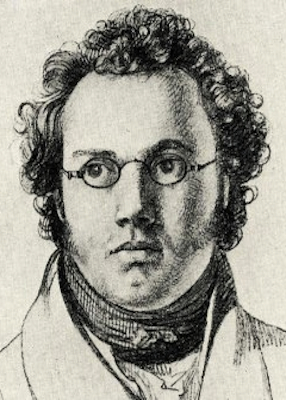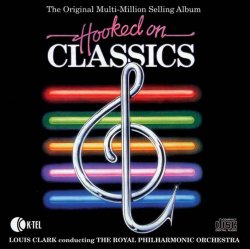
Symphony No. 44 in E minor, Hoboken I/44, was completed in 1772 by Joseph Haydn. It is popularly known as Trauer. An apocryphal story relates that Haydn asked for the slow movement of this symphony to be played at his funeral.

The Symphony No. 8 in F major, Op. 93 is a symphony in four movements composed by Ludwig van Beethoven in 1812. Beethoven fondly referred to it as "my little Symphony in F", distinguishing it from his Sixth Symphony, a longer work also in F.

The Symphony No. 94 in G major is the second of the twelve London symphonies written by Joseph Haydn. It is popularly known as the Surprise Symphony.

Ludwig van Beethoven's Symphony No. 1 in C major, Op. 21, was dedicated to Baron Gottfried van Swieten, an early patron of the composer. The piece was published in 1801 by Hoffmeister & Kühnel of Leipzig. It is not known exactly when Beethoven finished writing this work, but sketches of the finale were found to be from 1795.

Franz Schubert's Symphony No. 5 in B♭ major, D. 485, was written mainly in September 1816 and completed on 3 October 1816. It was finished six months after the completion of his previous symphony.

Symphony No. 2 in D major, Op. 73, was composed by Johannes Brahms in the summer of 1877, during a visit to Pörtschach am Wörthersee, a town in the Austrian province of Carinthia. Its composition was brief in comparison with the 21 years it took Brahms to complete his First Symphony.

The Symphony No. 100 in G major, Hoboken I/100, is the eighth of the twelve London symphonies written by Joseph Haydn and completed in 1793 or 1794. It is popularly known as the Military Symphony.

The Symphony No. 101 in D major is the ninth of the twelve London symphonies written by Joseph Haydn. It is popularly known as The Clock because of the "ticking" rhythm throughout the second movement.
Symphony No. 93 in D major, Hoboken I/93, one of the twelve London symphonies written by Joseph Haydn.
The Symphony No. 99 in E♭ major is the seventh of the twelve London symphonies written by Joseph Haydn. The symphony was written in 1793 in Vienna in anticipation for his second trip to London.

The Symphony No. 70 in D major, Hoboken 1/70, was written by Joseph Haydn to mark the start of construction of a new opera house on the Eszterháza estate. It was premiered on December 18, 1779—one of the few Haydn symphonies where the exact premiere date is known.

Symphony No. 34 in C major, K. 338, was written by Wolfgang Amadeus Mozart in 1780, and completed on 29 August that year.

The Symphony No. 63 in C major, Hoboken I/63, is a symphony by Joseph Haydn written sometime between 1779 and 1781. It is often known by the title of the second movement, La Roxelane, named for Roxelana, the influential wife of Suleiman the Magnificent of the Ottoman Empire. This second movement was originally part of Haydn's incidental music for Charles Simon Favart's stage work Soliman der zweite in which Roxelana was a character.
The Symphony No. 4 in C minor, D 417, is a symphony by Franz Schubert completed in April 1816 when Schubert was 19 years old, a year after his Third Symphony However, it was not premiered until November 19, 1849, in Leipzig, more than two decades after Schubert's death. The symphony was called the Tragic by its composer.

The Symphony No. 1 in D major, D 82, was composed by Franz Schubert in 1813, when he was just 16 years old. Despite his youth, his first symphony is an impressive piece of orchestral music for both its time and size. The first movement opens with a stately Adagio introduction, reminiscent of Joseph Haydn's 104th symphony in its format. The short Adagio sets off a lively Allegro vivace.
The Symphony No. 2 in B♭ major, D 125, is a symphony by Franz Schubert composed between 1814 and 1815. It is scored for 2 flutes, 2 oboes, 2 clarinets, 2 bassoons, 2 horns, 2 trumpets, timpani and strings.
The Violin Sonata No. 4 in A major, Op. posth. 162, D 574, for violin and piano by Franz Schubert was composed in 1817. This sonata, composed one year after his first three violin sonatas, was a much more individual work, showing neither the influence of Mozart, as in these previous works, nor of Rossini, as in the contemporaneous 6th Symphony.

The three String Trios, Op. 9 were composed by Ludwig van Beethoven in 1797–98. He published them in Vienna in 1799, with a dedication to his patron Count Johann Georg von Browne (1767–1827). They were first performed by the violinist Ignaz Schuppanzigh with two colleagues from his string quartet. According to the violinist and conductor Angus Watson, these were probably Franz Weiss on viola and either Nikolaus Kraft or his father Anton on cello. Each of the trios consists of four movements:

Schubert's Symphony in D major, D 708A, is an unfinished work that survives in an incomplete eleven-page sketch written for piano solo. It is one of Schubert's six unfinished symphonies. It was begun in 1820 or 1821, with initial sketches made for the opening sections of the first, second, and fourth movements, and an almost complete sketch for the third movement. He abandoned this symphony after this initial phase of work and never returned to it, although Schubert would live for another seven years. British conductor and composer Brian Newbould, an authority on Schubert's music, has speculated that the symphony was left incomplete due to problems Schubert faced in orchestrating the sketch.

Hooked on Classics, produced by Jeff Jarratt and Don Reedman, is a multi-million selling album recorded by Louis Clark and the Royal Philharmonic Orchestra, published in 1981 by K-tel and distributed by RCA Records, part of the Hooked on Classics series.











